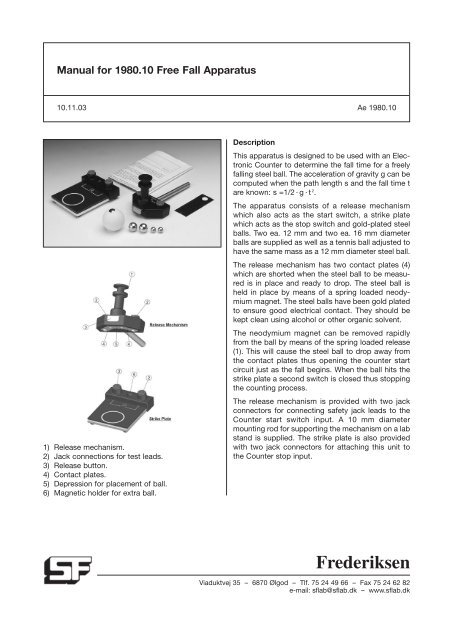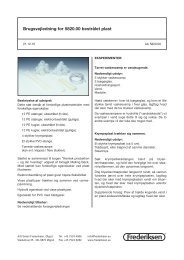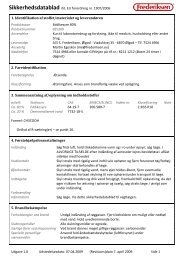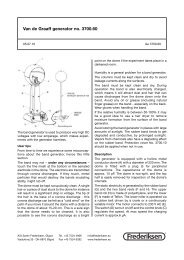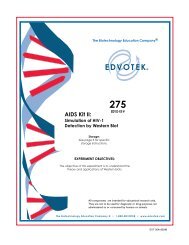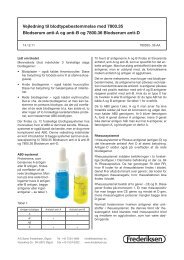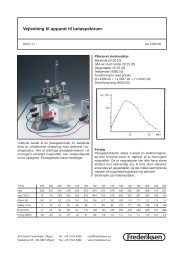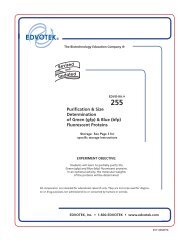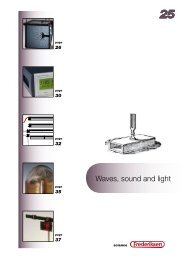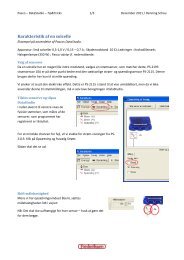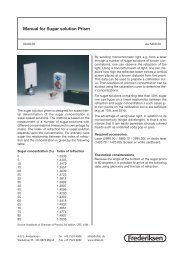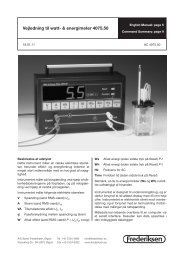198010 - Frederiksen
198010 - Frederiksen
198010 - Frederiksen
- No tags were found...
Create successful ePaper yourself
Turn your PDF publications into a flip-book with our unique Google optimized e-Paper software.
Manual for 1980.10 Free Fall Apparatus10.11.03 Ae 1980.101) Release mechanism.2) Jack connections for test leads.3) Release button.4) Contact plates.5) Depression for placement of ball.6) Magnetic holder for extra ball.DescriptionThis apparatus is designed to be used with an ElectronicCounter to determine the fall time for a freelyfalling steel ball. The acceleration of gravity g can becomputed when the path length s and the fall time tare known: s =1/2 · g · t 2 .The apparatus consists of a release mechanismwhich also acts as the start switch, a strike platewhich acts as the stop switch and gold-plated steelballs. Two ea. 12 mm and two ea. 16 mm diameterballs are supplied as well as a tennis ball adjusted tohave the same mass as a 12 mm diameter steel ball.The release mechanism has two contact plates (4)which are shorted when the steel ball to be measuredis in place and ready to drop. The steel ball isheld in place by means of a spring loaded neodymiummagnet. The steel balls have been gold platedto ensure good electrical contact. They should bekept clean using alcohol or other organic solvent.The neodymium magnet can be removed rapidlyfrom the ball by means of the spring loaded release(1). This will cause the steel ball to drop away fromthe contact plates thus opening the counter startcircuit just as the fall begins. When the ball hits thestrike plate a second switch is closed thus stoppingthe counting process.The release mechanism is provided with two jackconnectors for connecting safety jack leads to theCounter start switch input. A 10 mm diametermounting rod for supporting the mechanism on a labstand is supplied. The strike plate is also providedwith two jack connectors for attaching this unit tothe Counter stop input.<strong>Frederiksen</strong>Viaduktvej 35 – 6870 Ølgod – Tlf. 75 24 49 66 – Fax 75 24 62 82e-mail: sflab@sflab.dk – www.sflab.dk
The length of the fall s can be measured using aruler. Measure the distance from the bottom of theball when it is mounted in the release mechanism tothe strike plate. The mirror provided can be helpfulwhen making this measurement to avoid parallaxerror. See Figure 2.Important!In order to ensure as good a connection as possibleboth the contact plates and the steel ball are goldplated and must be kept absolutely clean. They canbe cleaned using an organic solvent. Some peoplehave moist fingers, and this can make it difficult toachieve good contact. The use of thin cotton glovescan be helpful in this case.Figure 2.OperationThe apparatus is assembled as shown in Figure 2.The release mechanism is readied by compressingthe spring release (1). The steel ball is placed in thedepression (5) between the contact plates (4) on therelease mechanism. The steel ball is released bypressing the push button. The connection betweenthe plates is broken, and the counter starts. Whenthe steel ball hits the strike plate placed verticallybelow the release point the counter is stopped.MaintenanceThe release mechanism spring should be relaxedduring storage. It is important to keep the ball andthe contact plates clean.Essential accessories:2002.50 Electronic counter.0001.00 Support stand base.0008.00 Support stand.0023.00 Stand fitting.Test leads - 4 ea.Spare parts1980.11 Extra set of gold plated steel balls.2
Table for copying:Fall path length, s =______________________________.Mass of ball, m = _______________________________Fall time (ms)g=(2s)/tCalculate the average value of g: _________________.Compute the deviation from the table value for g:3
FREELY FALLING BODIESLab exerciseTheoryPurposeThe goal of the exercise is to measure falling timesfor freely falling bodies in order to determine theacceleration of gravity. The experiment will also involvebodies where air resistance is significant. The<strong>Frederiksen</strong> free fall apparatus (1980.10) is used toilluminate the agreement between theory and experiment.Equipment1980.10 Free fall apparatus including steel ballsand ping pong ball.2002.50 Electronic counter.4 test leads.0001.00 Support stand base.0008.00 Support stand.0023.00 Stand fitting.SetupThe above figure shows a body falling under the actionof the earth’s gravity. The acceleration of gravityg = 9,82 m/s 2 . When the speed of the falling body increasesthe opposing force due to air resistance increases.It is assumed here that air resistance is proportionalto the square of the speed: F = k ·v 2 .The resultant force F RES on the body is given by:F RES = m ·g - k ·v 2Where it is assumed that the positive direction isdownward.Minimal air resistanceWe assume first that k = 0, i.e. That the force of airresistance is insignificant. ThusF RES = m ·g = m ·dv/dtWhere we have used Newton’s second law:F = m ·a = m dv/dt. Thus:dv/dt = gWhich has the complete solutionv(t) = g ·t + cWhere c is an arbitrary constant. If the motion beginsat t = 0, then this constant corresponds to the initialspeed v 0 :v(t) = g ·t + v 0Note that v = g · t when the initial speed v 0 = 0.Because the speed v = ds/dt, then the general formulaisds/dt = g ·t + v 0Which has the solutions(t) = 1 /2 ·g ·t 2 + v 0 ·t + s 0Where the constant of integration s 0 in this case correspondsto the initial position.4
If one assumes that the body is at rest (v 0 = 0) at theinitial position (s 0 = 0) at time t = 0, the followingresult:s = 1 /2 ·g·t 2 The force equation is an equation in two variables:the speed v and time t. They can be separated:ExerciseMeasure corresponding values of the fall distance sand the time for the fall t. Check by graphing s as afunction of t 2 whether this model is a good descriptionof the motion. The slope of the graph shouldcorrespond to 1 /2 ·g where g is the acceleration ofgravity.The equation can be solved by integrating both sides,integrating the speed from the initial value v 0 =0 and the time from t = 0 to the time t.By integration we obtain:s/mt/sMultiplying and reducing:Take the exponential function exp on both sides ofthe equation:This equation can now be solved for the speed v asa function of the time t:Which is the result sought for v(t). Using a spreadsheets(t) can be found by using the difference equations 1 = s 0 + v(t 1 )·∆t. A time interval ∆t og about 0.05s will usually be appropriate when analyzing datafrom the free fall apparatus.Free fall with air resistanceFor bodies having a low density (e.g. A ping pongball) air resistance becomes significant for the motion.I.e. It is no longer possible to set k = 0. In thiscase the force equation becomes:F RES = m ·g - k ·v 2 = m ·dv/dtWhere we again use Newton’s second law. Note thatthe constant k in the term describing air resistance isdependent upon the cross sectional area A of thefalling body, the density D of the medium (air) as wellthe form and surface of the object characterized byC W . The constant C W :k = 1 /2 ·D·A·C W .Transition to low air resistanceIt can now be shown that for small values of the coefficientk this formula is identical to the equationv(t) = g · t for motion without air resistance. This canbe done by exchanging the exponential function withthe two first terms of the Taylor series (e X ≈ (1 + X).For small values of k the exponent is close to zero sothat so that the speed equation can be rewritten:Where we have made use of the fact that the denominatorapproaches unity for small values of k. Inthis manner it is apparent that the exact expressionreduces to v = g · t for k · 0.5
ExercisePrepare a spreadsheet with the exact expression forv(t) and for s(t) using the difference equation s 1= s 0+ v(t 1)·∆t, and compare the result with the correspondingexpression without air resistance. Compare(t,v) and (t,s) graphs for various values ofk = 1 /2 ·D ·A · CwTheory and real data can be compared using the<strong>Frederiksen</strong> free fall apparatus. The density of air D= 1,293 kg/m 3 and the cross sectional area A can bedetermined, the value of the air resistance coefficientCW can be found. This is readily done by checkingwhich value of CW in the expression for v(t) whichgives the best agreement with the measured datawhen s(t) is computed in the spreadsheet using thedifference equation.ExerciseWith knowledge of CW it is possible to compute theterminal velocity for a falling body, for in this casem·g - k · v 2 = 0:This is also apparent for the limiting value of v(t) for tgoing towards infinity. Perform an experiment by lettingthe ball fall from a high spot (e.g. Top of a building).Does the object approach a constant speed.?<strong>Frederiksen</strong>Viaduktvej 35 – 6870 Ølgod – Tlf. 75 24 49 66 – Fax 75 24 62 82e-mail: sflab@sflab.dk – www.sflab.dk


